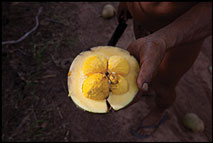Crossref Citations
This article has been cited by the following publications. This list is generated based on data provided by
Crossref.
Witcher, Robert
2019.
Editorial.
Antiquity,
Vol. 93,
Issue. 368,
p.
287.
Neves, Eduardo G.
and
Heckenberger, Michael J.
2019.
The Call of the Wild: Rethinking Food Production in Ancient Amazonia.
Annual Review of Anthropology,
Vol. 48,
Issue. 1,
p.
371.
Shock, Myrtle Pearl
and
Moraes, Claide de Paula
2019.
A floresta é o domus: a importância das evidências arqueobotânicas e arqueológicas das ocupações humanas amazônicas na transição Pleistoceno/Holoceno.
Boletim do Museu Paraense Emílio Goeldi. Ciências Humanas,
Vol. 14,
Issue. 2,
p.
263.
Capriles, José M.
Lombardo, Umberto
Maley, Blaine
Zuna, Carlos
Veit, Heinz
and
Kennett, Douglas J.
2019.
Persistent Early to Middle Holocene tropical foraging in southwestern Amazonia.
Science Advances,
Vol. 5,
Issue. 4,
Colonese, Andre Carlo
Winter, Rachel
Brandi, Rafael
Fossile, Thiago
Fernandes, Ricardo
Soncin, Silvia
McGrath, Krista
Von Tersch, Matthew
and
Bandeira, Arkley Marques
2020.
Stable isotope evidence for dietary diversification in the pre-Columbian Amazon.
Scientific Reports,
Vol. 10,
Issue. 1,
Gregorio de Souza, Jonas
Alcaina Mateos, Jonas
Madella, Marco
and
Biehl, Peter F.
2020.
Archaeological expansions in tropical South America during the late Holocene: Assessing the role of demic diffusion.
PLOS ONE,
Vol. 15,
Issue. 4,
p.
e0232367.
Kater, Thiago
2020.
A temporalidade das ocupações ceramistas no sítio Teotônio.
Boletim do Museu Paraense Emílio Goeldi. Ciências Humanas,
Vol. 15,
Issue. 2,
Watling, Jennifer
Almeida, Fernando
Kater, Thiago
Zuse, Silvana
Shock, Myrtle Pearl
Mongeló, Guilherme
Bespalez, Eduardo
Santi, Juliana Rossato
and
Neves, Eduardo Góes
2020.
Arqueobotânica de ocupações ceramistas na Cachoeira do Teotônio.
Boletim do Museu Paraense Emílio Goeldi. Ciências Humanas,
Vol. 15,
Issue. 2,
Mongeló, Guilherme
2020.
Ocupações humanas do Holoceno inicial e médio no sudoeste amazônico.
Boletim do Museu Paraense Emílio Goeldi. Ciências Humanas,
Vol. 15,
Issue. 2,
Iriarte, Jose
Elliott, Sarah
Maezumi, S. Yoshi
Alves, Daiana
Gonda, Regina
Robinson, Mark
Gregorio de Souza, Jonas
Watling, Jennifer
and
Handley, Josephine
2020.
The origins of Amazonian landscapes: Plant cultivation, domestication and the spread of food production in tropical South America.
Quaternary Science Reviews,
Vol. 248,
Issue. ,
p.
106582.
Cagnato, Clarissa
2021.
GATHERING AND SOWING ACROSS THE CENTRAL MAYA LOWLANDS: A REVIEW OF PLANT USE BY PRECERAMIC PEOPLES AND THE EARLY TO MIDDLE PRECLASSIC MAYA.
Ancient Mesoamerica,
Vol. 32,
Issue. 3,
p.
486.
Shock, Myrtle P.
2021.
South American Contributions to World Archaeology.
p.
219.
Leitão-Barboza, Myrian Sá
Kawa, Nicholas C.
Junqueira, André B.
and
Oyuela-Caycedo, Augusto
2021.
Open air laboratories: Amazonian home gardens as sites of experimentation, collaboration, and negotiation across time.
Journal of Anthropological Archaeology,
Vol. 62,
Issue. ,
p.
101302.
Prestes-Carneiro, Gabriela
Sá Leitão Barboza, Roberta
Sá Leitão Barboza, Myrian
Moraes, Claide de Paula
and
Béarez, Philippe
2021.
Waterscapes domestication: an alternative approach for interactions among humans, animals, and aquatic environments in Amazonia across time.
Animal Frontiers,
Vol. 11,
Issue. 3,
p.
92.
Pärssinen, Martti
Ferreira, Evandro
Virtanen, Pirjo Kristiina
and
Ranzi, Alceu
2021.
Domestication in Motion: Macrofossils of Pre-Colonial Brazilian Nuts, Palms and Other Amazonian Planted Tree Species Found in the Upper Purus.
Environmental Archaeology,
Vol. 26,
Issue. 3,
p.
309.
Bogaard, Amy
Allaby, Robin
Arbuckle, Benjamin S.
Bendrey, Robin
Crowley, Sarah
Cucchi, Thomas
Denham, Tim
Frantz, Laurent
Fuller, Dorian
Gilbert, Tom
Karlsson, Elinor
Manin, Aurélie
Marshall, Fiona
Mueller, Natalie
Peters, Joris
Stépanoff, Charles
Weide, Alexander
and
Larson, Greger
2021.
Reconsidering domestication from a process archaeology perspective.
World Archaeology,
Vol. 53,
Issue. 1,
p.
56.
Santos, Gilton Mendes dos
Cangussu, Daniel
Furquim, Laura Pereira
Watling, Jennifer
and
Neves, Eduardo Góes
2021.
Pão-de-índio e massas vegetais: elos entre passado e presente na Amazônia indígena.
Boletim do Museu Paraense Emílio Goeldi. Ciências Humanas,
Vol. 16,
Issue. 1,
2021.
Totemic Outsiders.
Religion and Society,
Vol. 12,
Issue. 1,
p.
70.
Chanca, Ingrid
Borges, Caroline
Colonese, André Carlo
Macario, Kita
Toso, Alice
Fontanals-Coll, Maria
Anjos, Roberto dos
Muniz, Marcelo
Pereira, Renan
Talamo, Sahra
and
Milheira, Rafael Guedes
2021.
Food and diet of the pre-Columbian mound builders of the Patos Lagoon region in southern Brazil with stable isotope analysis.
Journal of Archaeological Science,
Vol. 133,
Issue. ,
p.
105439.
Mora, Santiago
2021.
Serpentear: énfasis y preguntas en el pasado amazónico.
Mundo Amazónico,
Vol. 12,
Issue. 2,
p.
171.





